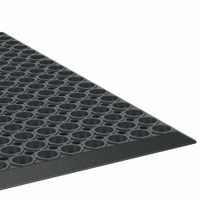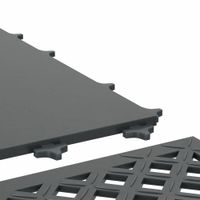Call +(254) 703 030 000 / 751 483 999 / 721 704 777
- Home
- Safety
- Floor Mats
- Antifatigue Drainage Mats
.....Read More
Frequently Asked Questions
What are antifatigue mats used for?
Antifatigue mats are designed to reduce fatigue caused by standing for extended periods on hard surfaces. They are commonly used in various environments such as workplaces, kitchens, and retail settings where individuals are required to stand for long durations. The primary purpose of these mats is to provide a cushioned surface that encourages subtle movements of leg and calf muscles, which in turn improves blood circulation and reduces the strain on joints and muscles.
Standing on hard surfaces for prolonged periods can lead to discomfort, pain, and long-term health issues such as lower back pain, leg pain, and varicose veins. Antifatigue mats help alleviate these problems by providing a softer, more forgiving surface that reduces the pressure on the feet and legs. The mats are typically made from materials like rubber, foam, or gel, which offer varying degrees of cushioning and support.
In addition to physical health benefits, antifatigue mats can also enhance productivity and morale in the workplace. By reducing discomfort and fatigue, employees are likely to experience less distraction and more focus on their tasks, leading to improved efficiency and job satisfaction. Furthermore, these mats can contribute to a safer work environment by reducing the risk of slips and falls, as many are designed with non-slip surfaces.
Overall, antifatigue mats are a practical solution for mitigating the adverse effects of prolonged standing, promoting better health, and enhancing workplace productivity.
How do drainage mats prevent slips and falls?
Drainage mats prevent slips and falls by providing a textured surface that enhances traction, allowing individuals to maintain better footing even in wet or oily conditions. These mats are designed with raised patterns or grooves that increase friction between the mat and footwear, reducing the likelihood of slipping.
Additionally, drainage mats are constructed with perforations or channels that facilitate the quick removal of liquids from the surface. This design ensures that water, oils, or other substances do not accumulate on the mat, which could otherwise create a slippery surface. By allowing fluids to drain away efficiently, the mats maintain a drier and safer walking area.
The materials used in drainage mats, such as rubber or vinyl, are often chosen for their durability and resistance to water and chemicals. These materials provide a stable and resilient surface that can withstand heavy foot traffic and harsh conditions, further contributing to safety.
Moreover, drainage mats often have beveled edges, which help prevent tripping by allowing a smooth transition from the floor to the mat. This feature is particularly important in high-traffic areas where people may not be paying close attention to their footing.
In environments like kitchens, industrial settings, or outdoor areas where moisture and spills are common, drainage mats are essential for maintaining safety. By effectively managing liquids and providing a stable surface, they significantly reduce the risk of slips and falls, protecting both individuals and businesses from potential injuries and liabilities.
What are the benefits of using antifatigue mats?
Antifatigue mats offer several benefits, particularly for individuals who stand for extended periods. These mats are designed to reduce fatigue and discomfort, enhancing overall well-being and productivity.
1. **Reduced Fatigue**: Antifatigue mats provide a cushioned surface that encourages subtle movements in the leg and calf muscles. This promotes better blood circulation, reducing the fatigue associated with prolonged standing.
2. **Improved Comfort**: The cushioning effect of these mats alleviates pressure on the feet, legs, and lower back, leading to increased comfort. This is particularly beneficial in workplaces like factories, kitchens, or retail environments where employees stand for long hours.
3. **Enhanced Productivity**: By minimizing discomfort and fatigue, antifatigue mats can lead to increased worker productivity. Comfortable employees are more likely to maintain focus and efficiency throughout their shifts.
4. **Reduced Risk of Injury**: Standing on hard surfaces for long periods can lead to musculoskeletal disorders. Antifatigue mats help in reducing the risk of such injuries by providing a supportive surface that absorbs shock and reduces strain on the body.
5. **Improved Posture**: These mats encourage better posture by providing a stable and supportive surface. This can help in reducing the risk of developing chronic back pain and other posture-related issues.
6. **Versatility**: Available in various sizes, materials, and designs, antifatigue mats can be used in diverse settings, from industrial environments to home kitchens, making them a versatile solution for different needs.
7. **Durability and Maintenance**: High-quality antifatigue mats are durable and easy to clean, ensuring long-term use with minimal maintenance.
Overall, antifatigue mats are a practical investment for improving comfort, health, and productivity in environments where standing is a significant part of daily activities.
Where should drainage mats be used?
Drainage mats should be used in areas where effective water management is crucial to prevent water accumulation and potential damage. They are typically employed in the following scenarios:
1. **Building Foundations**: Drainage mats are installed around building foundations to facilitate water movement away from the structure, preventing water from seeping into basements or crawl spaces, which can lead to structural damage and mold growth.
2. **Green Roofs**: On green roofs, drainage mats are essential for managing excess water, ensuring that plants receive adequate moisture while preventing waterlogging. They help in maintaining the structural integrity of the roof by reducing the load of retained water.
3. **Retaining Walls**: Behind retaining walls, drainage mats are used to relieve hydrostatic pressure by channeling water away from the wall, thus preventing water buildup that can lead to wall failure.
4. **Plaza Decks and Terraces**: In these areas, drainage mats are placed beneath the surface to ensure proper drainage of rainwater, protecting the underlying structure and preventing water pooling that can cause surface damage.
5. **Sports Fields and Golf Courses**: Drainage mats are used to maintain optimal playing conditions by ensuring quick drainage of rainwater, preventing waterlogging, and maintaining the integrity of the turf.
6. **Roadways and Pavements**: They are used beneath roadways and pavements to enhance drainage, reduce water-related damage, and extend the lifespan of the surface.
7. **Landscaping**: In landscaping, drainage mats help manage water flow in gardens and landscaped areas, preventing erosion and ensuring healthy plant growth.
8. **Balconies and Patios**: They are used to prevent water accumulation on balconies and patios, protecting the surface and underlying structure from water damage.
In all these applications, drainage mats play a critical role in water management, structural protection, and maintaining the longevity and functionality of various surfaces and structures.
How do interlocking mats work?
Interlocking mats work by utilizing a puzzle-like design that allows individual pieces to connect securely with one another. Each mat has edges shaped like jigsaw puzzle pieces, with protrusions and indentations that fit together. This design ensures that the mats stay in place once assembled, providing a stable and continuous surface.
The mats are typically made from materials like EVA foam, rubber, or PVC, which offer cushioning, durability, and resistance to wear and tear. These materials also provide shock absorption, making interlocking mats ideal for areas where impact protection is needed, such as gyms, playrooms, or workshops.
To assemble, users align the edges of two mats and press them together until the interlocking tabs click into place. This process is repeated with additional mats to cover the desired area. The interlocking mechanism prevents the mats from shifting or separating during use, maintaining a consistent surface.
Interlocking mats are versatile and can be easily customized to fit various spaces. They can be cut to size with a utility knife to accommodate corners or irregular shapes. Additionally, they are portable and can be disassembled and reassembled as needed, making them convenient for temporary setups or relocation.
The mats are also easy to clean and maintain. Most can be wiped down with a damp cloth or mild detergent, and their water-resistant properties help prevent damage from spills or moisture.
Overall, interlocking mats provide a practical flooring solution that combines ease of installation, flexibility, and durability, making them suitable for a wide range of applications.
What materials are antifatigue mats made from?
Antifatigue mats are typically made from a variety of materials designed to provide comfort and reduce fatigue for individuals who stand for extended periods. Common materials include:
1. **Rubber**: Durable and slip-resistant, rubber mats are often used in industrial settings. They provide good cushioning and are resistant to oils and chemicals.
2. **Foam**: Foam mats, often made from polyurethane or PVC, offer excellent cushioning and are lightweight. They are suitable for environments where comfort is prioritized over durability.
3. **Gel**: Gel mats combine a gel core with a foam or rubber exterior. They provide superior comfort and support, making them ideal for environments where prolonged standing is common.
4. **Vinyl**: Vinyl mats are durable and easy to clean, making them suitable for environments where hygiene is important. They often have a foam backing for added comfort.
5. **Carpet**: Some antifatigue mats have a carpeted surface, providing a softer feel and aesthetic appeal. These are often used in office settings.
6. **Nitrile Rubber**: Known for its resistance to oils and chemicals, nitrile rubber is used in environments where exposure to such substances is common.
7. **Closed-cell PVC**: This material is resistant to water and chemicals, making it suitable for wet environments. It provides good cushioning and is easy to clean.
8. **Recycled Materials**: Some mats are made from recycled rubber or other materials, offering an eco-friendly option.
Each material offers different benefits, such as durability, comfort, slip resistance, and ease of cleaning, making them suitable for various environments, from industrial to commercial and residential settings.
How do you clean and maintain antifatigue and drainage mats?
To clean and maintain antifatigue and drainage mats, follow these steps:
1. **Regular Cleaning**: Sweep or vacuum the mats daily to remove loose dirt and debris. This prevents buildup that can cause wear and tear.
2. **Deep Cleaning**: Weekly or bi-weekly, depending on foot traffic, perform a deep clean. Remove the mats and shake them to dislodge trapped dirt. Use a hose to rinse off any remaining debris.
3. **Use Mild Detergent**: Prepare a solution of mild detergent and warm water. Avoid harsh chemicals that can degrade the mat material. Scrub the mats with a soft-bristle brush to remove stains and embedded dirt.
4. **Rinse Thoroughly**: After scrubbing, rinse the mats thoroughly with clean water to remove soap residue, which can make the surface slippery.
5. **Dry Completely**: Allow the mats to air dry completely before placing them back in their location. This prevents mold and mildew growth. Hang them or lay them flat in a well-ventilated area.
6. **Inspect Regularly**: Check the mats for signs of wear, such as cracks or tears, which can compromise their effectiveness. Replace mats that are damaged beyond repair.
7. **Rotate Mats**: If possible, rotate the mats periodically to ensure even wear and prolong their lifespan.
8. **Use Mat Protectors**: In high-traffic areas, consider using mat protectors or additional layers to reduce direct wear on the mats.
9. **Follow Manufacturer’s Instructions**: Always adhere to the cleaning and maintenance guidelines provided by the manufacturer to avoid voiding warranties or damaging the mats.
10. **Store Properly**: If mats need to be stored, roll them up rather than folding to prevent creases and damage.
By following these steps, you can ensure that your antifatigue and drainage mats remain effective and durable over time.


